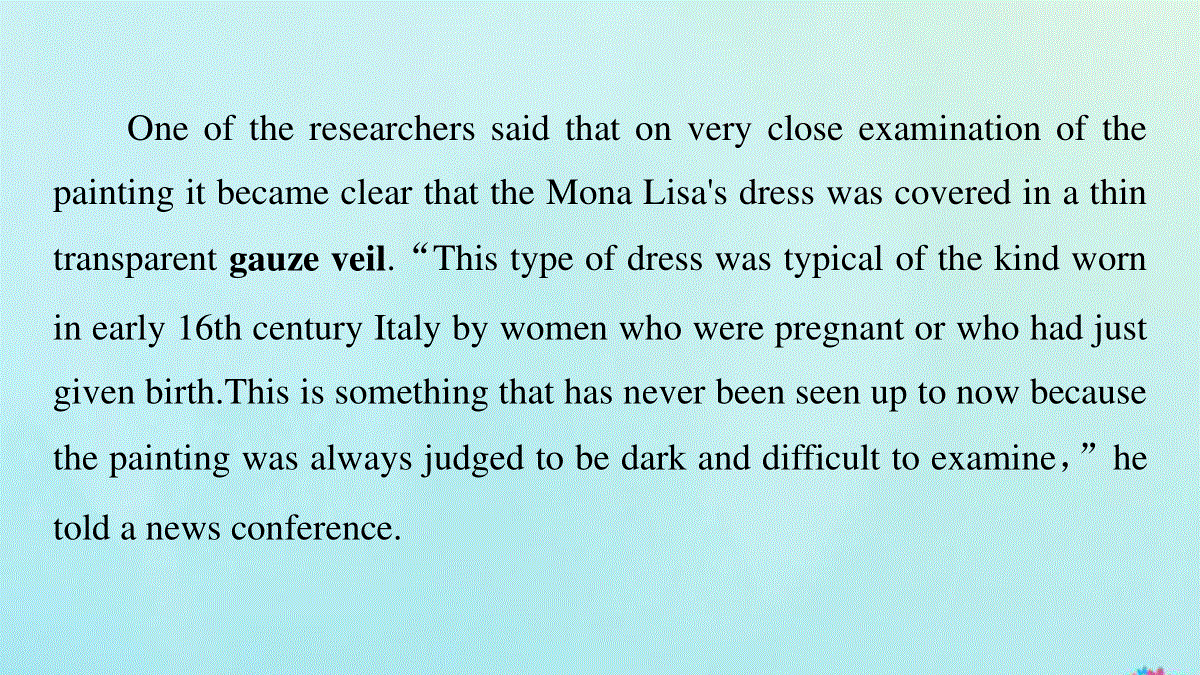Module2TheRenaissance达·芬奇16世纪创作的不朽名画《蒙娜·丽莎》中的女子一直充满着神秘的色彩。前不久,法国一位艺术家提出了新的见解。现在让我们一起来看看是怎么回事吧!MonaLisa,themysteriouswomaninLeonardodaVinci's16thcenturymasterpiece,hadjustgivenbirthtohersecondsonwhenshesatforthepainting,aFrenchartexpertsaidonTuesday.ThediscoverywasmadebyateamofCanadianscientistswhousedspecialtechnologytopeerthroughthepaintlayersonthework,whichnowsitsintheLouvreMuseuminParis.OneoftheresearcherssaidthatonverycloseexaminationofthepaintingitbecameclearthattheMonaLisa'sdresswascoveredinathintransparentgauzeveil.“Thistypeofdresswastypicalofthekindworninearly16thcenturyItalybywomenwhowerepregnantorwhohadjustgivenbirth.Thisissomethingthathasneverbeenseenuptonowbecausethepaintingwasalwaysjudgedtobedarkanddifficulttoexamine,”hetoldanewsconference.Healsosaidthat,contrarytopopularbelief,thesubjecthadnotletherhairhangfreelybutinfactworeabonnetfromwhichonlyafewcurlsmanagedtoescape.“PeoplealwayswrotethatMonaLisahadallowedherhairtohangfreelyoverhershoulders.ThisgreatlysurprisedhistoriansbecauselettingyourhairhangfreelyduringtheRenaissancewastypicalofyounggirlsandwomenofpoorvirtue,”hesaid.TheteamhadhopedtodiscovermoredetailsaboutLeonardo'spaintingtechnique,whichtheartistusedtocreateahazyeffect.ButscientistJohnTaylorsaidtheteamhadbeenfrustratedbythelackofbrushstrokedetailonthepainting.[阅读障碍词]1.peerv.凝视;盯着看2.gauzen.薄纱3.veiln.面纱4.bonnetn.(带子系于下巴的)旧式女帽5.curln.(一绺)卷发6.hazyadj.朦胧的[诱思导读]根据短文内容,回答下列问题1.WhendidMonaLisasitforthepaintingaccordingtothepassage?2.WhatwasthepopularbeliefaboutthepaintingMonaLisa?Aftershehadjustgivenbirthtohersecondson.MonaLisahadallowedherhairtohangfreelyoverhershoulders.SectionⅠWarmingUp,Pre-reading&Reading新生词汇初识Ⅰ.匹配下列单词的词性及汉语意思()1.disturbingA.adv.基本上,本质上,大致说来()2.subjectB.n.作品()3.dullC.n.效果;作用()4.basicallyD.adj.有技巧的,熟练的()5.workE.adj.引起烦恼的;令人不安的()6.effectF.n.(绘画,摄影等的)主题()7.shadeG.adj.枯燥的;沉闷的()8.frontierH.n.(图画等中的)阴影;阴暗部分()9.motivateI.n.新领域()10.skilledJ.v.激发,激励[答案]1-5EFGAB6-10CHIJDⅡ.选择下列句中词组的汉语意思A.第一次B.与……形成对照C.与……相比D.总之;简言之E.醒来;唤醒F.手拉手;密切合作G.也;不仅……而且H.永远1.Don'tletitplayonyourmind,becausemydevotionisforalltime.2.Ihavetowakeupat6amforIhavealotofthingstodo.3.Theyellowcurtainscontrastwiththebluebedcover.4.Imethimatthecinemaforthefirsttime.5.Hewenttothepartyaswellashissister.6.Inshort,finishingthejobisnotsoeasyasyoumaythink.7.Isawthemwalkinghandinhandthroughthetowntheotherday.8.Comparedwith/tocars,bicycleshavemanyadvantages.[答案]1-5HEBAG6-8DFC教材语篇细研TheRenaissanceFormanypeople,theRenaissancemeans14thto16thcenturyItaly,andthedevelopmentsinartandarchitecture,musicandliteraturewhichtookplacethereatthattime①.Butthereisoneworkwhich,perhapsmorethananyother,expressesthespiritoftheRenaissance:theMonaLisa.Itisbelievedtobe②thebestexampleofanewlifelikestyleofpaintingthatamazedpeoplewhenitwasfirstused.PaintedbyLeonardodaVinciintheyears1503-1506③,theMonaLisaisamysteriousmasterpiece.PeoplewanttoknowwhoMonaLisais,andwhysheissmiling④.EvenifpeopledonotknowmuchabouttheRenaissance⑤,theyhaveheardofthispainting.文艺复兴对于很多人来说,文艺复兴指的是14-16世纪时期的意大利,及其当时在艺术、建筑、音乐以及文学领域的发展。但有一件作品可能比其他的任何作品都更能表达文艺复兴的精神——《蒙娜·丽莎》。它被认为是一种新的形象逼真型绘画风格的最好代表,这种绘画风格一经使用就使人们惊叹不已。《蒙娜·丽莎》由莱奥纳多·达·芬奇于1503到1506年期间绘制而成,是一件神秘的杰作。人们想知道蒙娜·丽莎是谁,她又为什么在微笑。即使是对文艺复兴了解不多的人,他们也都听说过这幅作品。[助读讲解]①此处which引导定语从句,修饰先行词developments。②Itisbelievedtobe...“它被认为是……”,此处的it指代theMonaLisa。③Paintedby...是过去分词短语作状语。④此处and连接两个分别由who和why引导的宾语从句。⑤此处Evenif引导让步状语从句。ButtheRenaissanceis,ofcourse,morethanjustMonaLisa.RenaissanceisaFrenchwordwhichmeans“rebirth”⑥anditfirstappearedinEnglishinthe19thcentury.ThewordwasusedtodescribeaperiodinEuropeanhistorywhichbeganwiththearrivalofthefirstEuropeansinAmerica,anageofexploration,andthebeginningofthemodernworld.ItwasasifEuropewaswakingupafterthelongsleepoftheMiddleAges⑦.FromItaly,theideasoftheRenaissancerapidlyspreadnorthwardstoFrance,Germany,England,andtherestofEurope.当然文艺复兴不仅仅是《蒙娜·丽莎》。文艺复兴是一个法语单词,意为“再生”,于19世纪首次出现在英语中。这个词被用来描绘随着首批欧洲人抵达美洲而开始的那段欧洲历史,这是一段探险的历史,也是现代世界史的开端。仿佛欧洲在经历了中世纪的长眠之后,就要苏醒过来了。从意大利开始,文艺复兴的精神很快向北传遍了法国、德国、英国以及欧洲的其他国家。[助读讲解]⑥此处which引导定语从句,修饰先行词aFrenchword。⑦此处asif引导表语从句。TradewithotherpartsoftheworldmeantthatEuropewasgettingricher,too.Thismeantthatpeoplehadmoneytospendonthearts⑧;anditbecameeasierforartiststofindpeoplewhocouldaffordtobuytheirworksoremploythem⑨.LeonardoworkedforimportantpeoplesuchastheDukeofMilan,and,towardstheendofhislife,theKingofFrance.与世界其他地方的贸易意味着欧洲也在变得更加富裕。也就是说人们有钱来花费在艺术上,对于艺术家来说想要找到人来购买他们的作品或者雇用他们也更容易。莱奥纳多为一些重要的人物工作过,比如米兰公爵,在晚年他也曾经为法国国王工作过。[助读讲解]⑧此处不定式短语作后置定语,修饰money。⑨此处it为形式主语,真正的主语是不定式短语,其中包含一个who引导的定语从句,修饰people。RenaissanceartistsfoundnewideasfortheirworkinclassicalGreeceandRome.Buttheylookedforward,too,byopeningnewfrontiersinthearts.Paintersdiscoveredhowtouseperspective(透视效果)andtheeffectsoflight;composersputdifferentvoicestogetherandcreatedpolyphony(复调音乐)(“manyvoices”);architectspreferreddesigningbuildingswithmorelightwhichcontrastedwiththeheavinessoftheGothiccathedrals(大教堂)oftheMiddleAges⑩.文艺复兴的艺术家从古希腊以及古罗马的文献中来寻找他们作品的灵感。而他们也通过开辟新的艺术领域来展望未来。画家们发现了怎样利用透视和光的作用;作曲家们将不同的声音合到一起创造了复调音乐(“许多音调”);相比于中世纪哥特式教堂的沉重来说,建筑师们则更喜欢设计





 三七文档所有资源均是用户自行上传分享,仅供网友学习交流,未经上传用户书面授权,请勿作他用。
三七文档所有资源均是用户自行上传分享,仅供网友学习交流,未经上传用户书面授权,请勿作他用。
本文标题:2019-2020学年高中英语 Module 2 The Renaissance Section Ⅰ
链接地址:https://www.777doc.com/doc-8277382 .html